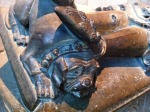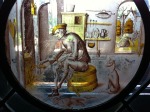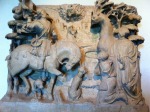Going Medieval: Animals of The Cloisters (the Metropolitan Museum of Art in Fort Tryon Park, NYC).
Month: May 2012
They are good, but we are better.
A brief clip in an 1889 issue of Our Dumb Animals describes a dinner conversation where a man tried to argue that the Japanese “are a more civilized people than the Americans,” based on the following scenario:
“[I]f, in a Japanese city, one picks up a stone to throw at a dog the dog does not run, because he has never had a stone thrown at him, and does not know what the action means. Manifestly, if such a state of universal gentleness and kindness prevails in Japan that not even a stone is thrown at a dog by a boy, there must be a very high and thorough civilization, permeating all classes of the population.”
It’s hard to imagine this American tourist in Japan ambling along the foreign streets, and thinking it a good idea to pick up a rock to “test” a stray dog’s reaction. It’s also hard to imagine that a dog (albeit one that has never been abused) wouldn’t recognize a stranger’s menacing attempt to hurl a projectile at him. The test, in short, seems flawed.
Still, the main point seems to be to goad American readers into feeling ashamed at the idea that the “little Jap” might surpass us in humaneness and civilization. Just in case this would offend some reader, the brief clip closes by gloriously appropriating for European-Americans the highest laurels:
“it is a significant fact that it was reserved for our own European-American civilization to introduce the completest refinement of cruelty to animals.”
To get a sense of how the Japanese were regarded around the turn of the century:

___________
Cited:
“Japanese Civilization.” Our Dumb Animals 22.6 (Nov. 1889).
Image from:
Mackay, Isabel E. “The Jingle of the Little Jap.” St. Nicholas 34 (May 1907).
Docking Horses’ Tails

An 1889 article from Our Dumb Animals, the organ of Massachussett’s animal protective society, rails against docking of horses’ tails. Docking, which involved severing horses’ tails down to the coccyx—and often also other operations to permanently redirect the direction of the amputated tail—was horribly painful, permanent, and (in terms of potential for infection) dangerous. Such “inflicting [of] needless pain” “is a disgrace to any person who lays claim to the possession of humane feelings” (“Mutilating”).


The docking question became an arena for debating issues of race and class:
“It is not only in bad taste, it is essentially barbarous. It belongs properly with the customs of tribes that flatten their heads, bore holes through their lips or noses, for the purpose of wearing a billet of wood suspended from such localities by a cord…” (“Mutilating”).
The Eurocentric racism is palpable: to docked tail is a primitive barbarian’s idea of beauty. Unlike these “tribes,” who “disfigure the features made by nature” (“Mutilating”), the Englishman is represented as a true lover of unblemished nature.

Paradoxically, docking and like practices (like “nipping” and “pricking”) were also linked to the upper class and their frivolous ideas of adornment—described as “refinement[s] of atrocity” (“Mutilating”), for example.

Left: “The flies do not bother me.”
Right: “They are eating me up.”
___________
Cited:
“Mutilating Horses.” Our Dumb Animals 22.6 (Nov. 1889).
Images from:
Magner, Dennis. Facts for Horse Owners. Battle Creek, MI: Magner Pub. Co., 1902.
Bear Found Not Guilty

(Photo of bear dens, most likely predating this case, but it might give us some idea of what the cages looked like in 1922.)
Feb 28 1922, Guzzi v. New York Zoological Society (192 N.Y. App. Div. 263, 182 N.Y. Supp. 257): A 12-year-old girl had climbed over a separating fence and laid her head underneath the bear cage to retrieve an errant ball. “The bear reached through the cage, caught her by the hair, and severely tore her scalp.” Agreeing with the trial court that the girl had “voluntarily placed herself in a place of danger,” the New York Court of Appeals unanimously affirmed the dismissal of a case against the Bronx Zoo.
One Bad Elephant

Gunda, a wild-caught elephant from India, offers the young readers of St. Nicholas an illustrative reformation story.
“From the moment he was taken from the crate Gunda was sullen, fierce, wickedly inclined, and considered dangerous…” For the first month, “Gunda’s only mission in life seemed to be the destruction of everything within reach of his trunk. He wrecked his stall, threatened his keeper, and gave many evidences of being genuinely bad elephant….”
A young trainer Frank Gleason took over the training of Gunda the “bad” elephant, and in just two days’ time, “[t]he wicked young elephant had become not only good, but really obedient, for he obeyed Gleason’s commands with an accuracy and willingness that made the Bronx officials marvel…. Now he is as gentle and lovable as one could wish.” Pawned out for pricey fifteen-cent rides and freely-offered for petting to visitors, Gunda seems to have become a beloved fixture of the Bronx Zoo.



Yet it is difficult for me to find much pleasure in this uplifting story of a “bad” elephant’s reformation. What, exactly, makes for a “bad” elephant? What wild animal, captured and transported thousands of miles into a lifetime of confinement, could be expected to “behave”? The article goes on to make mention of “Central Park Tom and others who became murderers and met a murderer’s fate”; alas, I haven’t found anything on this infamous Central Park Tom, but there is, of course, the infamous case of Topsy, the “bad” circus elephant who was electrocuted by Thomas Edison in 1903.
There’s a atatue dedicated to Romeo, a “serial killer” elephant, in Delavan, Wisconsin, some sort of “circus capital.” This site, Road Side America, also links to many other such ghastly memorials across the country. As recently as 1994, an elephant in Honolulu was shot for going “berserk” and killing its trainer. (No memorial).
As I poked around the web further, I just started feeling ill. The stills from the 2001 footage of the abuse of Britain’s last circus elephant, Anne, make me sick to my stomach. When can we announce our last?
_____________________
Cited:
Van Eaton, Helen D. “Gunda.” St. Nicholas: An Illustrated Magazine for Young Folks 32 (May-Oct. 1905). Ed. Mary Mapes Dodge.1090-1093
The Wild Effects of the Bronx Zoo

Inspired by my visit to the Bronx Zoo this past Sunday, I did some poking around for interesting nineteenth-century tales of the 113-year-old institution, and will posting on these all week. While not the first zoo in New York City—the Central Park menagerie, established decades earlier, bears that honor—the Bronx Zoological Park quickly became known as “the” New York zoo. As a 1913 visitor from London jealously put it,
“[w]ithin the two hundred and fifty acres of land and water comprised in the Bronx Zoological Park the visitor finds at once the expression of American ideals and the reproach of European zoos” (Aflalo).
This writer praises in particular the zoo’s emphasis on wide open spaces (“[p]erspective, immensity, a middle distance that would measure the furthest limit of Old World menageries”) that effectively mimick a “natural” or “wild effect”: “It is wild Nature, so cunningly adapted to the semi-artificial requirements of a menagerie….” (Aflalo).


Given American investment in accessing the reinvigorating, masculinizing “wild” during the turn of the century, the Bronx zoo could have been expected to quickly supplant the Central Park zoo in popularity, but in fact attendance at the midtown location spiked, “proving conclusively the growing folly of the suggestion heard occasionally, that the Central Park animals be transferred to the Bronx Zoological Gardens” (Dept. of Parks report). Then, as now, “the Central Park menagerie is of great service, being available to many thousands who could not afford the time nor the carfare for a visit” to the Bronx (Dept. of Parks report).
There is one function that the Central Park menagerie fulfilled then that it no longer does: raise sheep for sale. In Central Park’s annual sheep sale (held in June, most likely on the aptly-named “Sheep Meadow” lawn that today is pebbled over with suntanning loungers on any fair-weather day), the Zoo’s stock were “recognized as the first in the country” (Dept. of Parks report).

________________
Cited:
Aflalo, F.G. “The New York Zoo.” Zoological Society Bulletin 2.24-60 (Oct. 1906-Nov. 1913): 324-6.
Report for 1904. City of New York. New York: Martin B. Brown Co., 1905. 37-9.
Images from http://www.newyorkcityzoos.com/
“Selfish” Mothers (Happy Mother’s Day!)
During the nineteenth-century’s pet-keeping mania, periodicals exhorted parents, particularly mothers, to put aside their own convenience or dislike of animals in their homes in order to secure for their children the many pet animals that were required for its healthy development: ”Perhaps the mother is very busy, or…she may dislike animals…. Alas! How any mothers and fathers cherish their selfish ease and consult their convenience” (Eberhart 193).
Shaming and guilt-tripping parents was even an international exercise. The Matron of the London Hospital wrote for the American magazine, Babyhood, to persuade mothers to “submit to the additional inconvenience” for the sake of all the healthful benefits (Lückes 4).
_____________
Cited:
Lückes, Eva C.E. “Children and Pets.” Babyhood: A Monthly Magazine for Mothers 3. Ed. Leroy M. Yale. New York: Babyhood Pub. Co., 1887. 4-7. Google Book Search. Web. 9 Feb. 2012.
“Children’s Pets.” Everything About Dogs. Ed. Alvin George Eberhart. Camp Dennison, Ohio: Eberhart Kennels, 1902. Google Book Search. Web. 9 Feb. 2012.
Man = dog’s God?

A 1902 hobbyman’s article on fishing tangentially describes an intimate (and masculinized, in the context of its call for back-to-nature engagements) human-dog moment as follows:
“As for a dog, I am sure that his admiring love for his master is never greater than when they come in together from the hunt, wet and tired, and the man gathers a pile of wood in front of the tent, touches it with a tiny magic wand, and suddenly the clear, consoling flame springs up, saying cheerfully, ‘Here we are, at home in the forest….’ When the weary, shivering dog sees this miracle, he knows his master is a great man and a lord of things.”
The self-aggrandizement, attained through the representation of the “weary, shivering dog,” necessarily speechless at the “miracle,” is palpable.
Even as I look at the ad for a contemporary dog-training book by “energy therapist and intuitive coach” Catherine Whittaker, Become Your Dog’s God, I can’t help but find the idea of being my dog’s God to be kind of silly and old-fashioned. The more natural sciences-based narrative of being a dog’s “pack leader” is much more familiar—but are these really so different? Is the popular and pervasive narrative of humans being their dog’s alpha pack leaders perhaps just the secular version of man being dog’s god?
_________________
Cited:
Van Dyke, Henry. “The Open Fire.” Fisherman’s Luck, and Some Other Uncertain Things. New York: Charles Scribner’s Sons, 1902. 207-33. Google Book Search. Web.
Inspiring “Becoming Deference” in Cats

In 1894 Phil Robinson shares an anecdote of a cat who, being furiously chased by a dog, chooses to flee by running rather than climbing. “Had she forgotten the value of trees to cats?” he asks: “Had the instinct of feline self-preservation by climbing been evolved out of her by domestication?”. He goes on to suggest that it may be “moral” to “encourage our dogs to chase cats,” so as to “bring the cat back to its bearings.”
On the one hand, Robinson waxes poetic in the healthy prospect of the cat relearning “its wonderful climbing powers, that it now wastes.” “Waste” is a fascinating concept, particularly as applied to “powers”; after all, the dog is implicitly using its furious chasing powers to the author’s delight. If one is endowed with certain “powers,” is it somehow wrong (on an efficiency, aesthetic, or moral scale) to not use them to their fullest? Even if they are not needed? Even if they cause harm?
Yet while he seems to be earnestly seeking to see “wonderful…powers” in the cat, Robinson ultimately is interested in the practice as a feline performance of subservience to the dog. If frequently practiced, a good, furious chase by a dog once in a while would “inculcate a becoming deference towards dogs.” What would be “becoming” about such deference? In light of the fact that the dog was typically gendered masculine and the cat feminine, Robinson’s prescriptions for enforced feline deference through the threat of canine violence seem startlingly misogynistic.
___________
Cited:
Robinson, Phil. “During a Stroll.” Monthly Packet 88 (July-Dec. 1894). Eds. Christabel R. Coleridge and Arthur Innes. London: A.D.Innes & Co., 1894. 659-63. Google Book Search. Web.
Nature Makes Us Do Bad Things
William Cowper (the famous poet cited by one of the movie adaptations of Fanny Price in Jane Austen’s Mansfield Park [1814]) wrote a rather humorous set of poems, “On a Spaniel Beau, Killing a Young Bird” and “Beau’s reply.” Beau unapologetically attacks a wild bird against his master’s commands, to his master’s chagrin. The dog explains:
Sir, when I flew to seize the bird
in spite of your command:
A louder voice than your’s [sic] I heard,
And harder to withstand.
You cried “Forbear!” but in my breast
A mightier cried “Proceed!”
’Twas nature, Sir.
This pair of poems are part of a long, long discourse that constructs “nature” (the “wild,” the “animal,” etc.) in opposition to “culture” (“civilization,” the “human,” etc.). I love how the dog’s voice is so carefully beseeching even as he insists on his “natural” right to hunt and kill a wild bird.
The full poem is quite worth reading, for the spaniel makes a careful argument of rational self-defense. In this argument, he points out that he has never made an attempt on his master’s pet bird’s life, having made the (rather human?) distinction between his master’s beloved property and the rest of (unowned) avian life.








